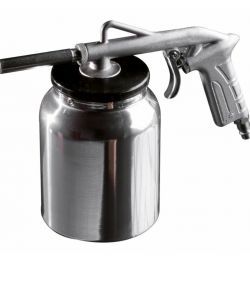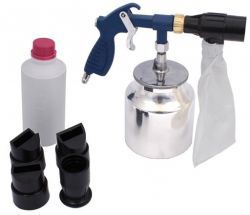FAQ
TL;DR: For DIY wood soda blasting, equipment matters: a 50 L compressor failed mid‑job; "the compressor damaged and everything stood still." This FAQ helps DIYers choose guns, compressors, granulation, and safer alternatives. [Elektroda, yanes, post #17084968]
Why it matters: Picking the right gun, compressor, and media prevents clogging, damage to wood, and expensive dead-ends for private projects.
Quick Facts
- Media: use sodium bicarbonate (NaHCO3); it’s hygroscopic, can clog nozzles, and needs higher air speed than sand. [Elektroda, Anonymous, post #17085768]
- Typical wood granulation: 0.1–0.3 mm soda, sold specifically for blasting. [Elektroda, yanes, post #17084968]
- Compressor: minimum ~50 L tank; single‑cylinder oil units cannot run continuously with a blasting gun. [Elektroda, tzok, post #17087100]
- Safety: never spray NaOH; apply by brush/roller only, with goggles and rubber gloves. [Elektroda, Krzysztof Kamienski, #17085708]
- Budget path: basic gun + promo compressor can total about 500 PLN for light, occasional use. [Elektroda, Pablo905, post #17085856]
Which media should I use for wood soda blasting—bicarbonate or lye?
Use sodium bicarbonate (NaHCO3), not sodium hydroxide (NaOH). Bicarbonate is low‑toxicity, water‑soluble, and gentle on surfaces. It is hygroscopic, so keep it dry to avoid clogging. Because soda is soft and light, you need higher air velocity than with sand to cut coatings. "An interesting option is also sandblasting grounded CO2 (dry ice)." Consider it if soda underperforms. [Elektroda, Anonymous, post #17085768]
What soda granulation works best for cleaning wood furniture?
For wood, use blasting soda around 0.1–0.3 mm. This grade balances surface friendliness with enough bite to lift finishes. Pair it with a nozzle sized for light media and keep the stream moving to avoid fiber raising. Store the bags sealed to reduce moisture pickup and clogging. [Elektroda, yanes, post #17084968]
What compressor specs do I need to run a soda blasting gun at home?
Plan on at least a 50 L tank. A simple single‑cylinder oil compressor cannot sustain continuous blasting. Expect short duty cycles and pauses for recovery. For larger jobs, you will wait for pressure to catch up. If you need uninterrupted flow, rent a bigger unit. [Elektroda, tzok, post #17087100]
Can I run a siphon gun from a bucket at 11 bar?
One user reported a setup with a gun, no hopper, and the pickup hose in a bucket at 11 bar. Results vary by compressor airflow, hose length, and media dryness. Test carefully in a controlled area and watch for clogging from humid soda. [Elektroda, SylwiaD-P, post #17085617]
Do I need a dedicated sandblaster cabinet, or will a hopper gun work?
You can blast with a gun that has a media container. The limiting factor is air supply. A small, single‑cylinder compressor will not support continuous blasting. For quick, spot work it is fine. For furniture‑scale jobs, plan breaks or rent more air. [Elektroda, tzok, post #17087100]
Should I rent a large construction compressor to try soda blasting?
Yes, for trials it’s practical to rent the largest compressor available. "I think it's cheaper to look for someone who comes with the equipment and will do it for you." Price out rental vs. hiring a service for your project size. [Elektroda, mladenick, post #17085091]
Will soda blasting damage wood details and carvings?
Soda is suitable for delicate surfaces like aluminum and wood. Keep pressure, stand‑off distance, and dwell time conservative on carvings. "It is used as abrasive for sanding delicate surfaces (aluminum, wood)." Always test on an inconspicuous area first. [Elektroda, tzok, post #17087100]
What goes wrong with a small 50 L compressor when blasting?
A real‑world case: 10 bags of soda were bought, but a 50 L compressor failed during the first bag. "The compressor damaged and everything stood still." Small tanks and limited duty cycles can stall projects and waste media. [Elektroda, yanes, post #17084968]
How do I strip paint from wood using NaOH safely?
Use a brush-on method, not spraying. Try this:
- Mix ~10–20% NaOH in water; apply with a brush on wood in a cool area.
- Wait until the finish softens; wrap in film if pausing; scrape or sponge off the "pudding."
- Rinse multiple times with clean water; wear goggles and thick gloves; keep vinegar and water ready.
NaOH may not pull deep stains. [Elektroda, artwa, post #17088775]
Why shouldn’t I spray NaOH with a gun?
"Spraying a caustic soda solution (NaOH) with spray gun is obvious idiocy." Apply only with a brush or roller. Wear safety goggles and rubber gloves as minimum PPE. Keep people and pets away. Dispose of residues responsibly. [Elektroda, Krzysztof Kamienski, #17085708]
Is sodium bicarbonate chemically safe around metal hardware?
Yes. Sodium bicarbonate is neutral to metals and does not attack them. Keep it away from acids, as it reacts and releases CO2. Rinse metal parts after blasting to remove residues before refinishing or reassembly. Dry thoroughly to prevent flash rust on bare steel. [Elektroda, Krzysztof Kamienski, #17087013]
Is dry‑ice blasting a better alternative for wood or moldy surfaces?
Dry ice impacts, then sublimates, which helps detach coatings without wet mess. "It is better to clean with solid CO2." It impressed users in mold remediation with sensitive shelving where chemicals were unsuitable. Availability and rental costs vary by region. [Elektroda, Anonymous, post #17087052]
How much does a budget DIY blasting setup cost?
A simple path: a low‑cost blasting gun (e.g., a promo unit from Lidl) and a promo compressor. Expect around 500 PLN total. This suits light, occasional tasks and experimentation. Start small, then scale if results meet your needs. [Elektroda, Pablo905, post #17085856]
How much does a professional soda blasting pistol cost?
A professional soda blaster pistol can cost about 56,000 PLN net. Consider total system needs too: high‑flow compressor, moisture control, and media handling. Weigh that against hiring a specialist for occasional furniture work. [Elektroda, Sofeicz, post #17089663]
Is it smarter to hire a pro instead of buying gear for one project?
For one‑off furniture or a large, detailed sideboard, hiring can be cheaper and faster. A pro arrives with the right blaster, airflow, and media. "Look for someone who comes with the equipment and will do it for you." Get quotes before buying. [Elektroda, mladenick, post #17085091]
Can NaOH remove modern acrylic paint from wood?
Not reliably. A user reported NaOH did not affect contemporary acrylics, requiring mechanical removal instead. Use scrapers, sanding, or soda for topcoats, then refinish. Always rinse and neutralize after chemical stripping before sanding to protect the wood. [Elektroda, artwa, post #17088775]
Can I use sand instead of soda on wood?
You can use sand with a low‑cost setup, but sandblasting wood risks surface damage and raised grain. If you try it, confirm the sand gradation and test on scrap. Many DIYers prefer soda for gentler action on furniture. [Elektroda, Pablo905, post #17085856]






